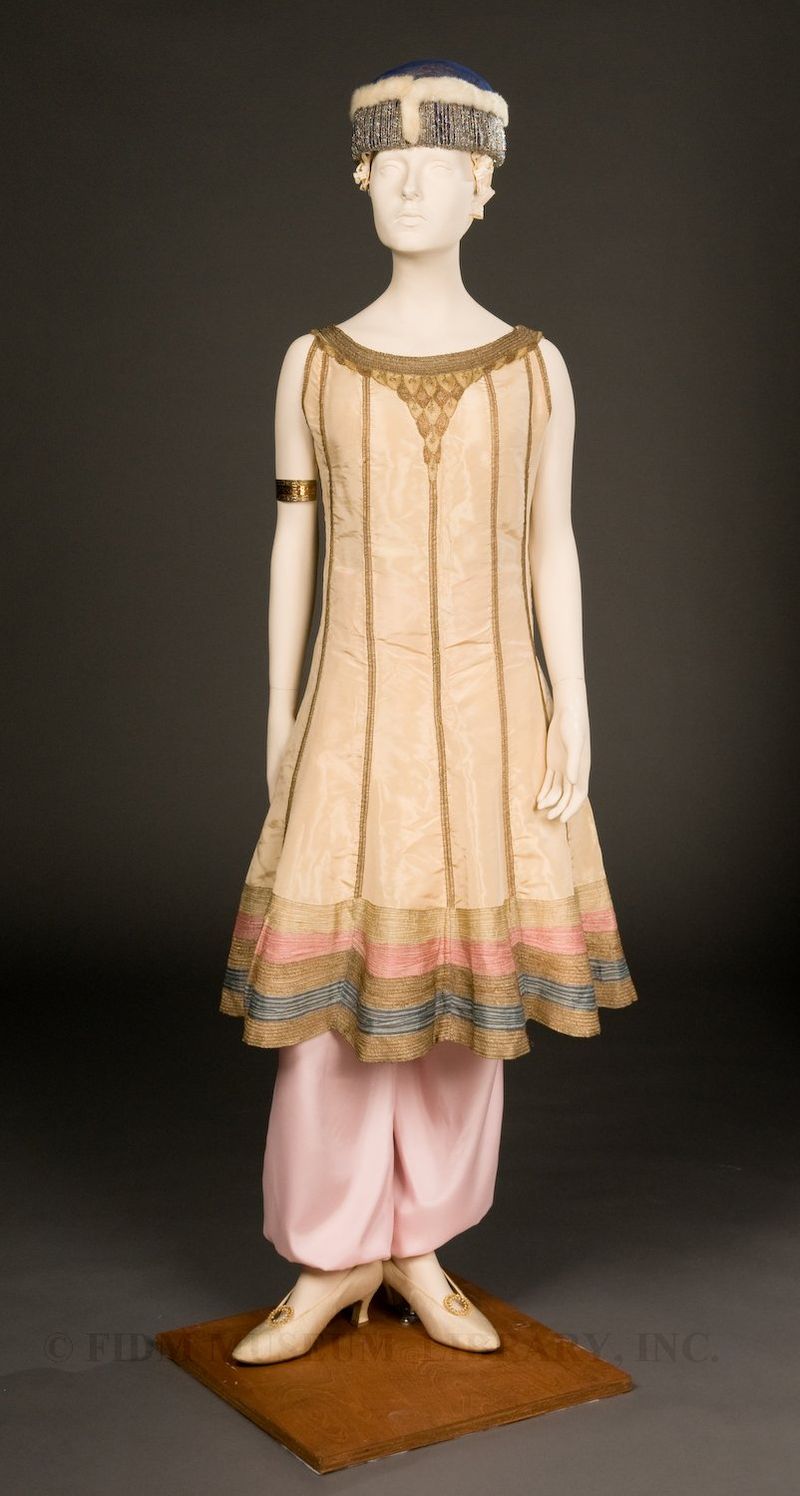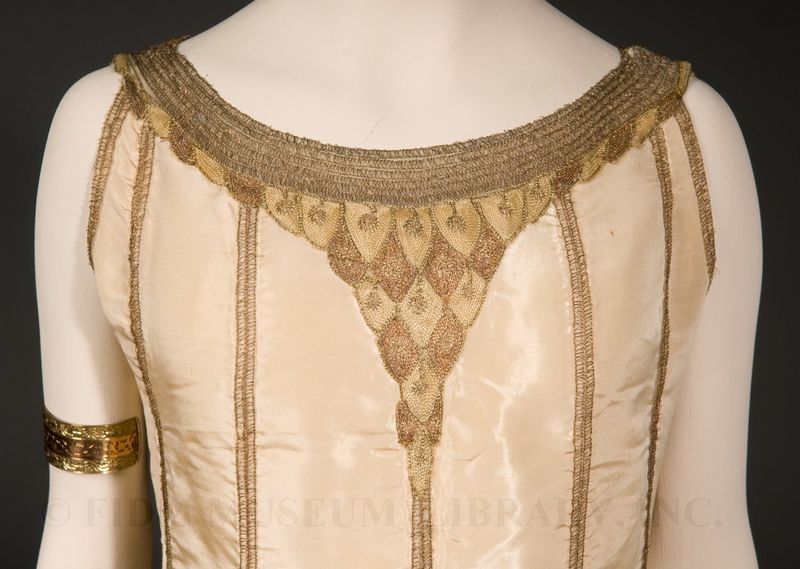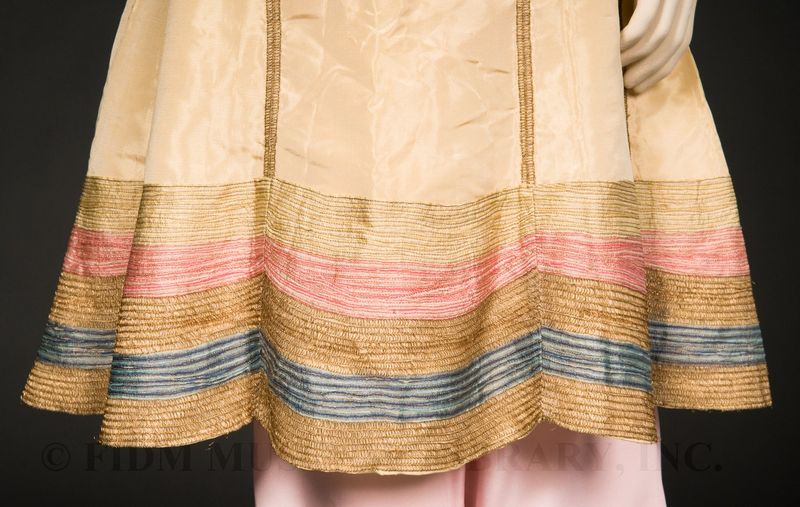Ladies come to me for a gown as they go to a distinguished painter to get their portrait put on canvas. I am an artist, not a dressmaker. Paul Poiret, 19131
Throughout most of the nineteenth century, the fashionable female silhouette stood away from the body and depended on multiple layers of garments for its shape. Petticoats, corsets, sleeve plumpers, and bustles were just some of the devices used in the nineteenth century to mold the female (and sometimes male) body. Applied decoration to the outermost layer of garments reinforced the impression of woman as ornate object. This began to change in the late nineteenth and early twentieth century when women became interested in activities which required ease of movement, such as bicycling, tennis and dancing. In conjunction with the emerging popularity of these pastimes, a more streamlined feminine silhouette emerged. Closely associated with the new silhouette was the Parisian designer Paul Poiret (1879-1944).
Beginning in 1898, Poiret worked for the grand couturier Doucet, though he soon moved to the House of Worth. In 1903, Poiret’s creation of a coat based on the shape of a kimono demonstrated that his aesthetic had evolved beyond that of his employer Charles Worth. Worth’s aesthetic depended on luxurious fabrics, corseted silhouettes and a generous application of applied decoration. Neither the client nor Worth appreciated Poiret’s relatively simple coat, so he left to open his own salon. Looking back on this turning point in his 1931 autobiography, King of Fashion, Poiret wrote that he had become tired of the dominant aesthetic, as “all that was soft, washed-out, and insipid, was held in honour.” 2
Though rejected by employer and client, Poiret’s kimono-style coat was indicative of the fashions he would promote and popularize throughout his career. His preferred silhouette was cylindrical and did not necessarily depend on a corset. In fact, Poiret often claimed that he was responsible for persuading women to abandon their corsets in the early years of the twentieth century. In creating these less-restrictive silhouettes, Poiret borrowed heavily from historic and regional dress with a specific interest in the Middle and Far East. In 1913, Poiret even went so far as to suggest that all American and European women would soon adopt “Oriental fashions altogether.”3
 Tunic
Tunic
Paul Poiret
c. 1913
Purchase
2008.25.4
In 1911, Poiret introduced “jupe-culottes” or harem pants. These full pants fell together almost as a skirt would and were worn under a tunic. This style was popular primarily among women with bohemian tendencies, as most women did not yet wear pants on a regular basis. The same tunic could also be worn over a skirt, a style much more acceptable to the general public. The fashion press dubbed this the “Persian silhouette,” in recognition of its supposed origins. This style was widely copied by other designers and the tunic/skirt combination proved especially popular. In 1913, Poiret pushed the tunic to its most extreme silhouette by inserting wire in the hem, forcing the so-called “lampshade” tunic to stand away from the body.
FIDM Museum’s Poiret tunic was featured in our 2008 exhibition, Aesthetes, Bohemians and Craftsman: Artistic Dress, 1880s-1920s. During the exhibition, the tunic was presented as you see in these images. Though our jupe-culottes are a reproduction, they are true to what would have been with the tunic.
Our tunic is embellished with metallic and silk embroidery in a pattern that emphasizes the columnar silhouette of the tunic and the jupe-culottes. Metallic embroidery was a favorite embellishment of Poiret’s and appears on many of his designs. Though Poiret is more often associated with strong, deep colors, as seen in these textile swatches, this tunic demonstrates his confident use of softer colors.
Throughout his career, Poiret insisted on a simple silhouette enriched by restrained yet sumptuous surface design. Visionary at its inception, Poiret’s cylindrical silhouette soon passed from avant-garde to commonplace. Other designers pushed his initial concept to its logical conclusion by producing easy-to-wear garments in sturdy fabrics. Poiret was unable to evolve or adapt and by the late 1920s, he was no longer at the forefront of fashion. By the time of his death in 1944, Poiret’s non-corseted silhouette was about to be replaced by Christian Dior’s corseted New Look of 1947.
In 2009, Poiret would certainly be interested to know that harem-style pants are an easily acquired item, available at multiple price points. They are still, however, highly debated. You can read an academically-oriented discussion of this style here or a trend-oriented discussion here.
1 “Paul Poiret Here To Tell of His Art” The New York Times 21 Sept. 1913.: 11.
2 Poiret, Paul. King of Fashion.Trans by Stephen Haden Guest. Philadelphia: Lippincot. 1931. 93.
3 “M. Poiret Coming Here” The New York Times 24 Aug. 1913.: C11.




Thanks for the link to Threadbared, FIDM! We appreciate our exchanges with fashion and textile historians, from whom we draw so much of the inspiration for our own work.